Elizabeth M. Middleton
NASA Goddard Space Flight Center
Winner of the 2012 Nordberg Award
NASA Goddard Space Flight Center
Winner of the 2012 Nordberg Award

|
Elizabeth M. Middleton
NASA Goddard Space Flight Center Winner of the 2012 Nordberg Award |
 |